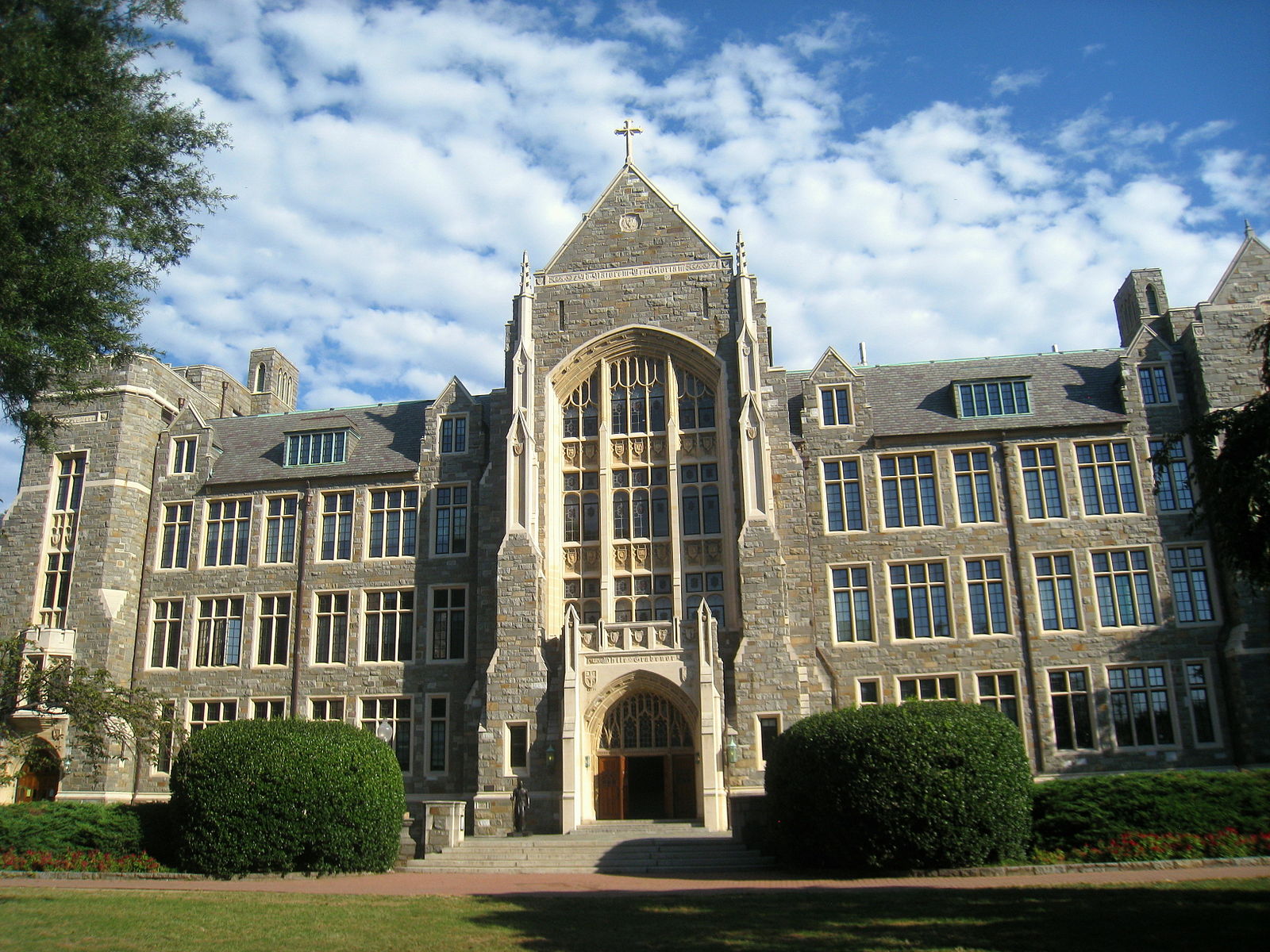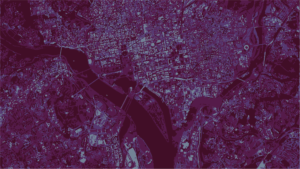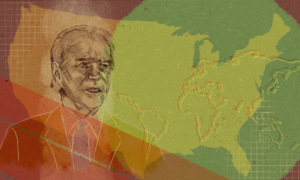In a continuation of dialogue about racial justice at the university, Georgetown College hosted a series of panels to discuss the role of higher education in anti-racism. The five events held during October brought together faculty members working in related fields to explore dimensions of racial structures in the United States, as well as the connections of their research to global questions of racial justice.
Titled “Such a Time As This,” the series takes its name from Esther 4:14, which reads in full: “For if you remain silent at this time, relief and deliverance for the Jews will arise from another place, but you and your father’s family will perish. And who knows but that you have come to your royal position for such a time as this?”
Newly-named Dean of the College Soyica Colbert introduced each session.
“This series emerged in response to the racial violence that unfolded over this summer but draws attention to our faculty’s much longer consideration of racial justice and the university’s role in advancing it,” she said.
Defining Our Terms: Ethical vision, moral mandate
The first discussion in the series laid out how education has an impact on principles students carry forward, and the connections between movements such as Black Lives Matter in the U.S. with global movements for greater racial equity.
Professor Gwendolyn Mikell, interim chair of anthropology, traced these themes in her own work, which has recently transitioned from studies of the African continent to research closer to home. The first Black tenured professor at Georgetown, Mikell has led both the African Studies Program and the Anthropology department. Describing her current work, she said, “I’m trying to bring anthropology back home and, in my more recent work, looking at the ways in which we can examine the experiences of people like me that were in the Chicago educational system during the civil rights legislation.”
Mikell’s recent project focuses on two specific Chicago high schools and her own class of graduates from them to tell the story of the first classes of university students in integrated schools and their divergent paths. “The teachers were determined that when that legislation actually passed, they would have a cohort of students to push through the doors once they opened,” she said of her own experience.
After that cohort graduated, however, they left.
“The neighborhoods out of which these students came, which were already redlined and deprived of economic opportunity, were then deprived of the contributions that these students could have made because they often went off to other places and stayed,”she said. Mikell herself went on to Columbia University and now Georgetown, and in discussions with her peers, came to terms with her own departure. “It is our responsibility now to contribute to racial justice for those communities,” she said.
Speaking about his own experiences in higher education, Terrence Johnson, associate professor of religion and politics, stressed the impact his race had on how he was viewed. , “Early on, I wanted to write as a scholar. And what I realized is, it doesn’t matter what you write: they’re always going to see you as a Black scholar,” Johnson said.
As a professor at Georgetown and former student at Morehouse College, a historically Black university, Johnson noticed a difference in methodologies between classically elite institutions and the school he attended. At the first, he feels, students often go to get credentialed rather than seeking a transformative experience like he had at Morehouse. “You actually go because you want to become a better person. So I’m trying to bring that into the classroom: ‘Do you want to remain the same person, or do you want some sort of transformative moment?’” he said.
Mikell reiterated the importance of teachers and professors in addition to a diverse and anti-racist curriculum. “If I look at the School of Foreign Service, they were aware of the contributions that my research could make to their understanding of international affairs,” she said. “But they were not as conscious of the need for diversity among the faculty members.”
Johnson also pointed out areas of improvement for the university, including improving the intellectual life and culture among the student body for students of color. “What do we do when we have diversity; what do we do when we bring them here?” he said.
The university also must consider how it employs its resources to educate students who may arrive without exposure to conversations about anti-racism, according to Johnson. “We’re celebrating racial justice in a way that’s still tied to an identity and not tied to, say, knowledge production,” he said of the curriculum at Georgetown. “Structurally, we have to do a better job of making sure our students are engaged and see [identities] not as separate, but as fundamental to who we are as a university.”
Racial justice and the arts
Bringing together two professionals in the performing arts world, both members of the Georgetown faculty, the second panel engaged with themes of cross-cultural understanding and racial justice as communicated through art.
A new faculty member at Georgetown, Assistant Professor in the Department of Performing Arts Carlos Simon spoke about his research into the university’s role in buying and selling slaves. In collaboration with other faculty members and the performing arts community, Simon composed a requiem investigating these historical issues of racial injustice. He said his reasons for pursuing this were “one, to honor my ancestors, and to really give them due because the university is indebted to their sacrifice. But also to show how slavery is so deeply embedded into our American culture and society.”
Simon, a celebrated composer and musician, found a way to bring archival texts to life through his work, spending time reading bills of sale and archival documents, as well as interviewing descendants of the 272 slaves Georgetown sold, to inform his composition. “I wasn’t always a professor; I am first a Black man in America, and I grew up on the south side of Atlanta,” he said of the work’s personal significance. “I’ve made a point of using my platform to talk about these things, which is music and as a professor at Georgetown.”
Natsu Onoda Power, a professor in theatre and performance studies, has made a career out of turning historical text and contemporary research into art. Her present work has made her reconsider racial power relations on a personal level. Through writing and performing pieces about protests against U.S. military bases on Okinawa, she has come to realize her role as a mainland Japanese woman living in the U.S. as intertwined with these global issues. “My present-day happiness is predicated, however indirectly, on the suffering of the Okinawan people,” she said, even as she continues to face the difficulties that come along with living as a woman of color in the U.S.
Both Simon and Power had to adapt their performance work in light of the COVID-19 pandemic, though each saw positives in the way it affects their art forms. “In the classical concert space, it was really a space meant for the elite, for people who had money,” Simon said. The pandemic has altered the fundamentals of live performance, according to Simon, leveling out former distinctions in access.
Power reflected on similar changes in the theatre landscape. “Equal access and representation has not been a strength of American theatre,” she said. “If we can harness this moment to make it as such, then I think that’s a positive transformation.”
Intersectionality, women acting up
The participants in the third panel reflected on the importance of an intersectional analysis of racial justice, as well as the ways their research complicates broad-stroke historical narratives. Intersectionality, they argued, gives a clearer and more nuanced picture of societal narratives, avoiding monolithic generalizations.
Regine Jean-Charles, associate professor of romance languages and literatures and Africa and African diaspora studies at Boston College, summarized her approach: “When I think about racial justice, it has to be approached through an intersectional lens. We’re talking about the ways in which different forms of oppression exacerbate one another.”
Applying the same principle to her work on Latinx history and labor movements, visiting Assistant Professor of History and American Studies Mireya Loza spoke about power relations in agricultural work in the U.S. “What I try to do is look at power: how does the nation-state develop mechanisms and exploit this uneven relationship of power with other countries,” she said.
Loza argued that simplistic narratives of Latinx immigration have created a category of the “expendable worker.” The workers who become the backbone of the American agricultural economy are at a constant power disadvantage, according to Loza. “They’re designed to be perpetual outsiders,” she said.
An intersectional approach to the issue of labor and food production also illuminated what Loza calls the “valorization of single men” as an essential part of the workforce, while women in that field, she said, are often subject to both labor and sexual exploitation, especially undocumented immigrants.
Assistant Professor of Government Jamil Scott added that intersectionality is needed in the conversation of women in the political sphere as well. “When we have this conversation about women running for office or taking part in politics, are we excluding women of color when we talk in this language of women and people of color [separately]?” she asked. “I firmly believe that women of color have their own story about why they decide to engage in politics, and some of that has to do with the violence they’ve been subjugated to in the United States.”
Research critiquing racial inequity and the efforts of academics to engage on these issues is not new, each of the professors said; but the increased awareness and willingness to have a dialogue has brought their specialties to the forefront.
Scott mentioned that the election cycle and increased awareness of violence against Black people in the United States has shifted her habits. “I’ve been a lot more active in being out and talking and engaging. I want folks to see that there are real things at stake and there should be a consideration of what this means,” she said.
This does not mean the research they are talking about is new.
“We’ve been here. I’ve been teaching this way for a very long time; I learned this way. You feel kind of vindicated, to be honest,” Jean-Charles added, addressing the spotlight on racial justice as a result of this year’s events. “There are a lot of people for whom it’s not really a rupture but a continuation, if you think about Black studies as a long project.”
“These are sometimes not new problems; the configurations might be new,” Loza added. “This is the moment where my research, my teaching, and what I do outside of the classroom have come together.”
Racial justice, science, and health
The pandemic has resurfaced issues of racial disparities in healthcare and science as the virus continues to have an outsized impact on communities of color. Combining knowledge of medical history and practice with an analysis of law and environmental justice, the panel explores how these outcomes are rooted much further back than 2020.
Professor Lakshmi Krishnan, director of Georgetown’s Medical Humanities Initiative, said, “You simply cannot undertake this work looking at health practices without grappling with the profound impact of medical racism, historically and currently.”
With advanced degrees in both medicine and English, Krishnan’s area of research focuses on combining humanities and medical methodology to more completely study medical history and current practices. “As we know, pandemics reveal all of these inequalities and fractures in such profound ways,” she said, referring both to the current pandemic and historical outbreaks such as the 1890 and 1918 influenzas. “The groups most affected by it and often ignored in medical offices tended to be the marginalized of that time,” she said. And the same holds true today.
“At the beginning of the pandemic, it was often said that the virus does not discriminate,” said Professor Sheila Foster. “But when they land on an unequal landscape, it exposes the inequalities that we have.”
For instance, Foster mentioned, in urban areas where people of color have had to move farther from the city, in part due to gentrification, they were at greater risk of contracting COVID-19 because of a reliance on public transport and jobs that did not have work-from-home options. The correlation of the coronavirus’s effects on pre-existing conditions with the higher levels of air pollution and obesity in communities of color also has roots in policy and legal failures.
“The way in which we regulate things is that we take things in very categorical ways. Civil rights law asks whether we’ve intentionally discriminated,” Foster said. “They do not account for the cumulative and synergistic effects of multiple phenomena.”
Krishnan and Foster also raised the issue of deep distrust of the medical and scientific communities among many American people of color. “[Institutions] use white male bodies to set standards that are applicable to all of us. It doesn’t tell us what the social cost of climate change is going to be, spread across different communities,” Foster said. “Our hard science has got to be open to acknowledging the reality on the ground and the inequalities without diluting the standards that science plays by.”
Krishnan reflected on her own medical education and residency in Baltimore, where there is a complicated relationship between Black residents and the medical establishment. “I trained not that long ago, but we were taught in medical school that race is biological. And now we are seeing this grassroots, student-driven change in trying to rebuild the medical curriculum,” she said. “As an educator, this is where I think the university has a role in undoing this.”
Spatial Politics: Prisons, cities, and borders
The final event in the series examined narratives around immigration and spaces open or restricted to different communities of color in the United States. The panelists combined research on global and diasporic issues with case studies of U.S. cities.
Jennifer Boum Make, assistant professor in the department of French and francophone studies, tied the creation of racial stereotypes around Haitian immigrants since the 1970s to a larger account of a hospitality mindset as a way to break down social and cultural constructions.
“All the literary accounts that were published in English since the 1970s participated in an intense production and circulation of racial stereotypes,” Make said. “Images of Haiti and populations of Haitian migrants have come to establish radical differences between the self, part of the western imagination, and the other.”
The appropriation and misrepresentation of marginalized voices has created exclusionary patterns surviving to this day, according to Make. “In the context of the U.S., I would say that if you look at the broad picture of recent immigration policies, it looks pretty dismal, and it’s hard to pull out any hospitable attitudes from the governmental body,” she said.
Conducting research on Mexican immigrants in Chicago, Assistant Professor of History Mike Amezcua found echoes of stereotypical messaging in efforts to preserve segregation. His exploration of real estate practices and displacement and state violence in the post-WWII period showed layered explanations for the marginalization of the Chicago Latinx community. “It’s not enough to look at urban renewal displacement, but you have to look at it in the context of federal investment in deportation campaigns. And in Chicago in particular, these two federal projects overlapped in neighborhoods where Mexicans congregated,” he said.
In some cases, court proceedings in deportation cases were left out altogether, and organized campaigns on the part of white residents to “keep their white neighbors in the city” motivated racial divisions. Amezcua spoke about simultaneous efforts on the part of Mexican residents to make space for themselves in the city.
Amezcua applied similar principles to the university, describing it as part of the ecology of cities and spaces. He called on universities to mobilize their resources “so that we don’t contribute to the displacement and erasure of our neighbors.”
***
Bringing together dialogues about faculty research and its application to anti-racism, professors reminded the university community of the ways in which we can be active contributors to racial justice in our roles as students, faculty, administrators, and staff. At Georgetown, they proposed marshaling the considerable financial and intellectual resources at our disposal to respond to broader societal issues present within and beyond the campus grounds.






[…] When Racial Justice Meets Academia: Georgetown Professors on the Study of Anti-Racism The Georgetown Voice […]